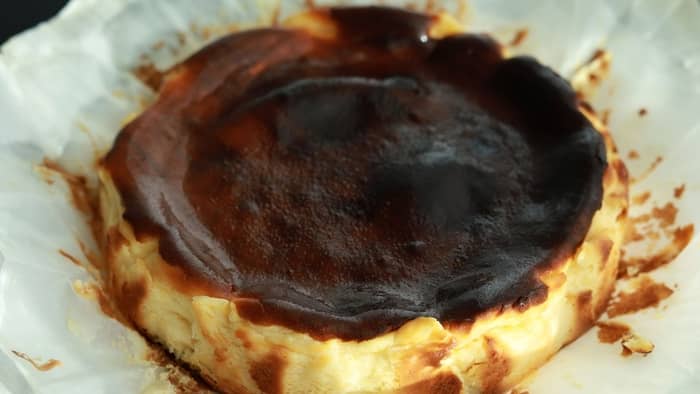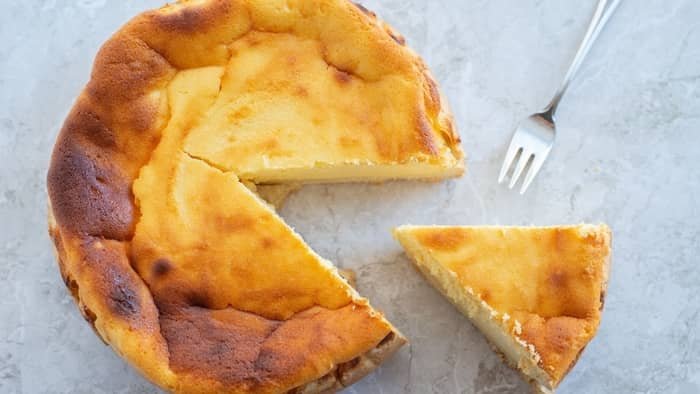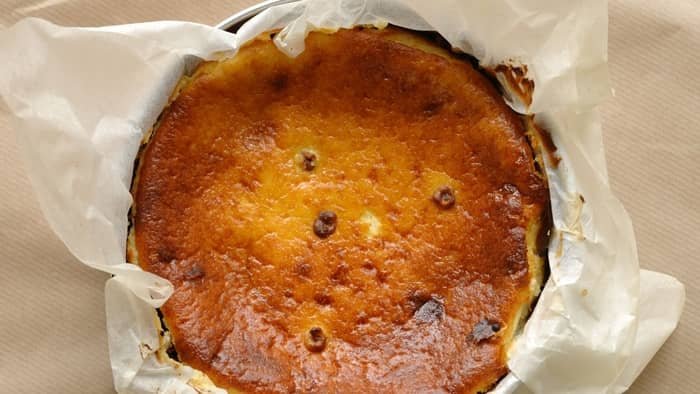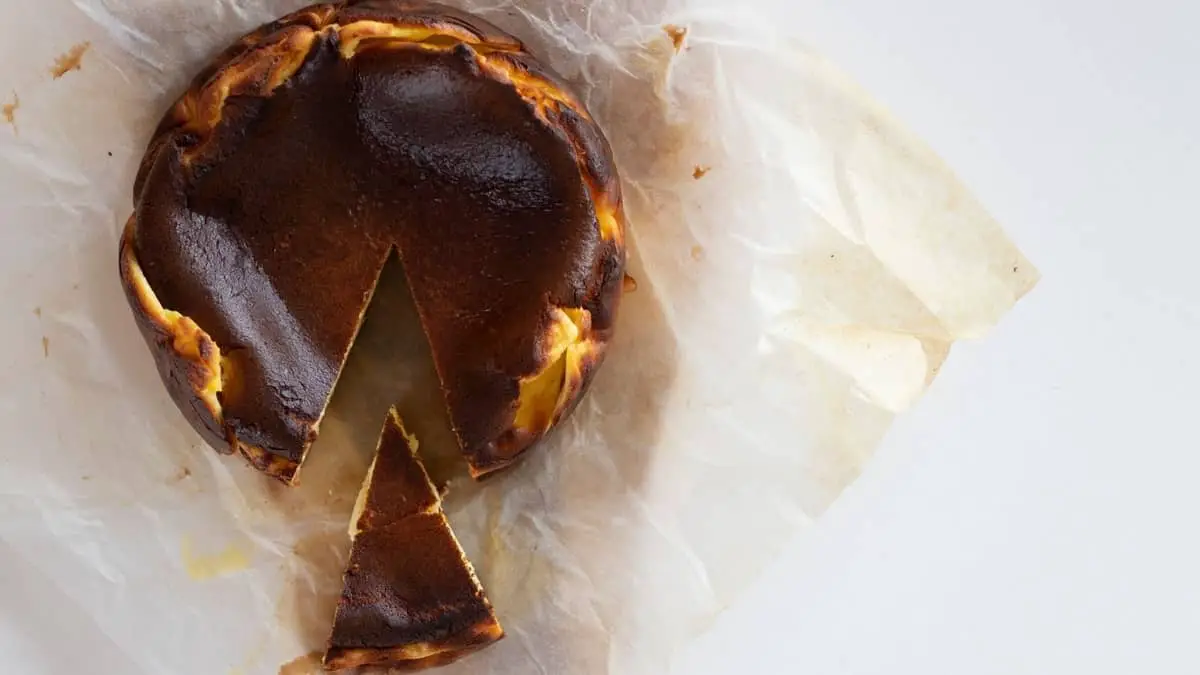By Lindy Van Schalkwyk, last updated on February 1, 2022
There are few things as frustrating as a sunken baked cheesecake. So, do you want to know how to fix a sunken cheesecake?
In today’s in-depth guide, we will explain exactly why cheesecakes have the tendency to sink in. But, we will also cover the many ways you can easily prevent this from happening. And, these techniques will even help you prevent cracks in your cheesecake too!
Why Did My Cheesecake Sink?
This is a problem many bakers run into. Not only when baking cheesecakes but cakes in general. Sunken baked goods are the worst, especially because there are so many factors that could have caused it.
To understand exactly why your cheesecake has sunken and how to fix a sunken cheesecake, you need to understand the science behind making a cheesecake.
How Cheesecake Work
When you are making a baked cheesecake batter, you use cream cheese sugar and eggs. Those are the only ingredients that you need. Any additional ones are to achieve specific textures and create other flavors.
When combining these three basic ingredients, they can be compared to making a type of custard. For baked custards specifically, the eggs are what help set the structure. When they are heated (during baking), the proteins coagulate. This forms a network that supports the weight of the remaining ingredients.
So, if there isn’t enough structure, it causes the cheesecake to start sinking and cause a crack. These two faults often go hand-in-hand.

What Causes The Cheesecake To Sink?
The reason that there isn’t enough structural support could be caused by three things.
Cause 1: Underbaking
The first is that the cheesecake wasn’t allowed to bake for long enough. It could also be that it was removed from the oven too soon. Even if the edges of the cheesecake are completely baked, the center may not be.
So, when the eggs in the middle of the cheesecake haven’t yet fully coagulated, there isn’t enough support to hold the weight of the cream cheese, and finally, the structure completely collapses and cracks.
Cause 2: Large cracks
If you have a cheesecake that has been fully baked but incorrectly cooled, it will still crack. And, if the crack is large enough, it means that there is a lack of support in that area
This will then also cause the cheesecake to sink in.
Cause 3: Incorrect recipe
When looking at a cheesecake recipe, the amount of eggs you need is essential. Too little and there won’t be enough structural support to hold the remaining ingredients. This will cause the cheesecake to sink.
However, too many eggs will create a very dense texture that could even make a rubbery cheesecake.
The number of eggs is also usually affected by the other ingredients used in the recipe. The heavier the ingredients, the more eggs you would need to support their weight. So, this is also often the reason for sunken cheesecake.
How To Prevent Cheesecake From Sinking
Cracks are the number one reason a cheesecake sinks. So, the best way to prevent your cheesecake from sinking in is to prevent a crack from forming. Here are the best techniques we use to get the perfect cheesecake and ultimately, how to fix a sunken cheesecake.
Tip 1: Make Sure Your Recipe Works
Cheesecakes require very specific ratios of ingredients. As we have mentioned before, you need a sufficient amount of eggs to support the structure. But, not so much as to make the texture rubbery.
By only using cheesecake recipes from reliable websites, you can entirely prevent the cheesecake from sinking in. It’s as simple as that!
To give you a general idea, your average 9-inch cheesecake will need at least 2 eggs. But, more often than not they call for 3. This is enough to give the cake the needed support and creamy light texture.

Tip 2: Properly Cool Your Cheesecake
If your cheesecake is exposed to sudden temperature changes, it causes the internal structure to relax and contract. This eventually causes the cheesecake to crack, even if it was perfectly baked.
For this reason, you should take care when cooling your cheesecake. The best and fail-proof method to follow is to first cool the baked cheesecake in a cooling oven for an hour. You can crack the door slightly to slowly lower the temperature.
Then, remove the cheesecake and allow it to cool for another hour at room temperature. Finally, wrap the cake pan with plastic wrap and set it in the fridge for at least another 6 hours.
So, no cracks, no sunken in cheesecake!
Tip 3: Don’t Underbake Your Cheesecake
This is incredibly important. You have to bake your cheesecake for long enough so that the middle is as evenly cooked as the edges. Often people remove the cheesecake because they feel that the edges are firm. But, the eggs haven’t yet coagulated in the center.
So, to properly test whether or not your cheesecake has been baking for long enough, you can wiggle it. If the center 1 or 2 inches moves like jello, the cheesecake has been baked for long enough.
Remember, when you are cooling the cheesecake in the switched-off oven, the residual heat will continue baking it and completely setting the eggs in the center.
This technique is great to prevent underbaking and overbaking the cheesecake.

Tip 4: Use A Water Bath
Baking cheesecake in a water bath will help bake it much more evenly than without. It slowly heats the cheesecake batter and prevents it from overbaking.
This way you can flawlessly determine when the cheesecake reaches the perfect jiggle. You can have a look here at exactly what a water bath is and how to use it.
How To Keep Cheesecake From Falling Apart
So, cheesecakes will obviously fall apart when there are cracks in the middle. But, even after you have baked and set the perfect cheesecake, the risks still aren’t completely gone.
A lot of times, bakers’ cheesecakes fall apart during the removing step. The cheesecake or crumb sticks to the sides and when you loosen the springform cake pan, it tears the cake apart.
The easiest way to prevent it from breaking is to prevent it from sticking to the sides. It is essential that you grease your cake pan with butter or non-stick cooking spray.
If you have a cheesecake that has a massive crack inside and you know it is very likely that it will break apart, rather leave it inside of the pan. It will be more difficult to slice and remove out of the pan, but it’s your only option.
But hey, broken pieces of cheesecake will still taste equally good if you don’t mind the crumbly appearance!

Conclusion – How To Fix A Sunken Cheesecake
Did you find this tutorial on how to fix a sunken cheesecake informative? Let us know in the comments below. And, if you know of anybody that could use some tips for preventing sunken cake, share this guide with them too.
[rank_math_rich_snippet id=”s-dee9d858-1f6e-419a-b934-4407a3490026″]

Lindy Van Schalkwyk is a culinary specialist with a background in Advanced Cooking, Advanced Pâtisserie, Media Communications and Nutrition. She has gained invaluable experience in the culinary industry having worked in some of the top restaurants in Africa in 2016 and 2017. Her expertise in nutrition has enabled her to develop recipes for special dietary needs. In 2018, Lindy began working in the Food Media industry, focusing on recipe development, recipe writing, food writing and food styling.

